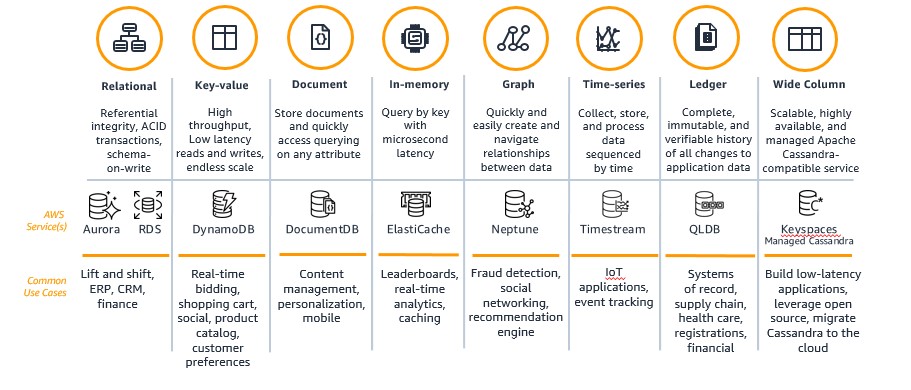AWS Public Sector Blog
Purpose-built databases: The model for building applications in the cloud
In the Forbes article, “IDC Top 10 Predictions For Worldwide IT, 2019,” IDC highlights that by 2022, 90 percent of all new apps will feature microservices architectures and that 35 percent of all production apps will be cloud-native. Microservices architectures improve the ability to design, debug, update, and leverage third-party code. Why is this trend becoming so pervasive? The answer relates to a higher-level trend: the transition away from large monolithic architectures.
In the public sector, we see this trend becoming more widespread. Often, organizations built critical, constituent facing applications on monolithic environments that inhibit innovation and create gaps in resiliency. During the initial days of COVID-19, many state and local agencies struggled to maintain constituent services as their backend systems were on mainframes or other legacy architectures. In addition to these systems being unable to buoy the increase in user demand, they also lived on older technologies that were not familiar to the current generation of IT experts. In reality, this transition has been happening for years, as organizations moved from mainframes to client-servers and now to cloud-based distributed systems. The era of the cloud has simply accelerated the push to microservices as organizations want to adopt new, distributed models for building applications to drive agility, innovation, and efficiency. The Amazon Web Services (AWS) portfolio of purpose-built databases can help with this movement.
What is a microservice architecture?
Microservices are an architectural model that gives modern developers a way to design highly scalable and flexible applications by decoupling the application into distinct services that perform specific functions. Modern applications are not uniform—they vary greatly in the data volume and data types they utilize. In addition, applications often have unique requirements in the form of latency or scale. Therefore, application developers no longer want to be tied to a single, over-burdened, database. Microservices enable services to communicate with other services through standardized application programming interfaces (APIs), allowing for the use of different programming languages or best of breed technologies. This differs greatly from systems built on monolithic structures where services are tightly coupled and must be scaled together, creating several operational challenges. Learn more about how to deploy microservices on AWS.
Why purpose-built databases for the public sector
Microservices architectures are a modern methodology of developing applications that empower organizations to deploy purpose-built technologies, including database elements. Developers are looking for the right database to meet their application’s unique requirements for functionality, performance, and scale. The one-size-fits-all approach of using a relational database for everything no longer works. When we discuss the concept of purpose-built databases, customers are often looking for clarity in the messaging so a metaphor might be the best way to explain.
Let’s say one day, your child or a young relative asks you to help them build a birdhouse for a school project. You go to your toolbox, and the only thing you have is hammer. You could continue down the path of trying to build the birdhouse, and you might be able to build some form of construct, but odds are you might end up with something that is less than ideal.
What if you had every tool you might need at your disposal? Imagine what you could build.
AWS offers a broad and deep portfolio of purpose-built databases that support diverse data models and allow customers to build data driven, highly scalable, distributed applications. This allows you to pick the best database to solve a specific problem and break away from restrictive commercial databases to focus on building applications to meet the needs of their organization. This increases business agility to deploy resources faster, innovate faster, and reduce time to value.
Now let’s take a look at a customer example. Ânima Educação, a leading education technology (EdTech) company in Brazil, wanted to modernize their learning management systems (LMS) application and product development environment. They tied their backend and development environments to a single, integrated software and hardware solution. This solution was expensive and incapable of scaling to meet their ever-growing demand. In addition, their developers were not as familiar with this technology stack.
The LMS system was broken down into several microservices, which they implemented in Amazon Elastic Kubernetes Service (Amazon EKS). Currently, they have deployed approximately 60 microservices, and 95 percent of the customer’s workloads are on AWS. The implementation of the LMS environment in the cloud enabled elasticity, providing service to all students at peak times, and delivered a 30 percent reduction in costs. Finally, in addition to modernizing their development environment, Ânima started using Amazon Redshift and a data lake in Amazon Simple Storage Service (Amazon S3) to help democratize data within the organization. This enabled the creation of critical dashboards for internal stakeholders.
Watch this video to hear João Talles Batista, Ânima’s senior software architect, detail their new digital platform that uses Amazon EKS, Amazon Elastic Compute Cloud (Amazon EC2), Amazon S3, Amazon Aurora, Amazon Relational Database Service (Amazon RDS), Amazon ElastiCache, Amazon CloudFront, and Amazon Redshift for analytics. And check out the breakout session, “Transform distance learning with the cloud” at this year’s AWS Public Sector Summit Online to hear more from João.
Learn more during AWS Database Modernization Week
AWS Database Modernization Week is a no-cost online event series designed to help you understand how to leverage purpose-built databases to accelerate your data modernization projects. We designed this event to give business leaders and anyone new to AWS databases a 100-200 level introduction to the AWS purpose-built database strategy, use cases, and customer success stories.
AWS Database Modernization Week will continue with more advanced technical sessions March 30–April 1 that are designed to give technical users the opportunity to dive deeper into AWS database services. You’ll explore new features and hear how to use these services to get the fastest performance at the highest scale. Join us for any or all of the week’s sessions that interest you.

